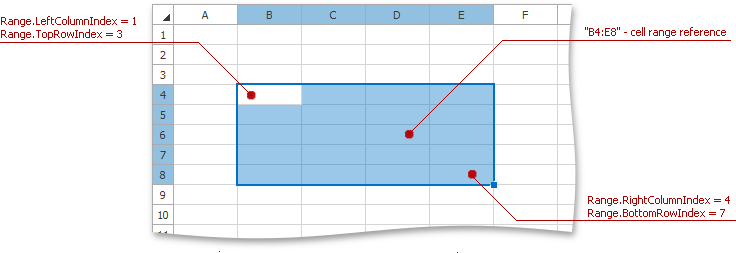IRangeProvider.Item[String] Property
Gets a cell range by its reference string.
Namespace: DevExpress.Spreadsheet
Assembly: DevExpress.Spreadsheet.v18.2.Core.dll
Declaration
Parameters
| Name | Type | Description |
|---|---|---|
| reference | String | A string that specifies the cell range reference in the A1 reference style. |
Property Value
| Type | Description |
|---|---|
| Range | A Range object. |
Remarks
Get the IRangeProvider object via the Worksheet.Range property and use the Item property to access a cell range object. Note that this property requires the cell range reference in the A1 reference style, regardless of which reference style is used in the workbook (DocumentSettings.R1C1ReferenceStyle). If you need to get a cell range by its R1C1 reference, use the IRangeProvider.Parse method.
To get a cell range by the indexes of the bounding rows and columns, use the IRangeProvider.FromLTRB method.

Example
This example demonstrates how to access ranges of cells in a worksheet. There are several ways to accomplish this.
- Use the Worksheet.Item property.
- Use the
IRangeProvider.Item, IRangeProvider.Parse and IRangeProvider.FromLTRB members of the IRangeProvider object, accessed via the Worksheet.Range or Workbook.Range property.
using DevExpress.Spreadsheet;
// ...
Workbook workbook = new Workbook();
Worksheet worksheet = workbook.Worksheets[0];
// A range that includes cells from the top left cell (A1) to the bottom right cell (B5).
Range rangeA1B5 = worksheet["A1:B5"];
// A rectangular range that includes cells from the top left cell (C4) to the bottom right cell (E7).
Range rangeC4E7 = worksheet.Range["C4:E7"];
// The C4:E7 cell range located in the "Sheet3" worksheet.
Range rangeSheet3C4E7 = workbook.Range["Sheet3!C4:E7"];
// A range that contains a single cell (E7).
Range rangeE7 = worksheet.Range["E7"];
// A range that includes the entire column A.
Range rangeColumnA = worksheet.Range["A:A"];
// A range that includes the entire row 5.
Range rangeRow5 = worksheet.Range["5:5"];
// A minimal rectangular range that includes all listed cells: C6, D9 and E7.
Range rangeC6D9E7 = worksheet.Range.Parse("C6:D9:E7");
// A rectangular range whose left column index is 0, top row index is 0,
// right column index is 3 and bottom row index is 2. This is the A1:D3 cell range.
Range rangeA1D3 = worksheet.Range.FromLTRB(0, 0, 3, 2);
// A range that includes the intersection of two ranges: C5:E10 and E9:G13.
// This is the E9:E10 cell range.
Range rangeE9E10 = worksheet.Range["C5:E10 E9:G13"];
// Create a defined name for the D20:G23 cell range.
worksheet.DefinedNames.Add("Range_Name", "Sheet1!$D$20:$G$23");
// Access a range by its defined name.
Range rangeD20G23 = worksheet.Range["Range_Name"];
Range rangeA1D4 = worksheet["A1:D4"];
Range rangeD5E7 = worksheet["D5:E7"];
Range rangeRow11 = worksheet["11:11"];
Range rangeF7 = worksheet["F7"];
// Create a complex range via the Range.Union method.
Range complexRange1 = worksheet["B7:C9"].Union(rangeD5E7);
// Create a complex range via the IRangeProvider.Union method.
Range complexRange2 = worksheet.Range.Union(new Range[] { rangeRow11, rangeA1D4, rangeF7 });
// Create a complex range from multiple cell ranges separated by commas.
Range complexRange3 = worksheet["D15:F18, G19:H20, I21"];
// Fill the ranges with different colors.
complexRange1.FillColor = Color.LightBlue;
complexRange2.FillColor = Color.LightGreen;
complexRange3.FillColor = Color.LightPink;
// Use the Areas property to get access to a complex range's component.
complexRange2.Areas[2].Borders.SetOutsideBorders(Color.DarkGreen, BorderLineStyle.Medium);